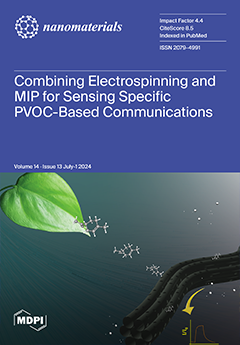In recent years, smart windows have attracted widespread attention due to their ability to respond to external stimuli such as light, heat, and electricity, thereby intelligently adjusting the ultraviolet, visible, and near-infrared light in solar radiation. VO
2(M) undergoes a reversible phase
[...] Read more.
In recent years, smart windows have attracted widespread attention due to their ability to respond to external stimuli such as light, heat, and electricity, thereby intelligently adjusting the ultraviolet, visible, and near-infrared light in solar radiation. VO
2(M) undergoes a reversible phase transition from an insulating phase (monoclinic, M) to a metallic phase (rutile, R) at a critical temperature of 68 °C, resulting in a significant difference in near-infrared transmittance, which is particularly suitable for use in energy-saving smart windows. However, due to the multiple valence states of vanadium ions and the multiphase characteristics of VO
2, there are still challenges in preparing pure-phase VO
2(M). Machine learning (ML) can learn and generate models capable of predicting unknown data from vast datasets, thereby avoiding the wastage of experimental resources and reducing time costs associated with material preparation optimization. Hence, in this paper, four ML algorithms, namely multi-layer perceptron (MLP), random forest (RF), support vector machine (SVM), and extreme gradient boosting (XGB), were employed to explore the parameters for the successful preparation of VO
2(M) films via magnetron sputtering. A comprehensive performance evaluation was conducted on these four models. The results indicated that XGB was the top-performing model, achieving a prediction accuracy of up to 88.52%. A feature importance analysis using the SHAP method revealed that substrate temperature had an essential impact on the preparation of VO
2(M). Furthermore, characteristic parameters such as sputtering power, substrate temperature, and substrate type were optimized to obtain pure-phase VO
2(M) films. Finally, it was experimentally verified that VO
2(M) films can be successfully prepared using optimized parameters. These findings suggest that ML-assisted material preparation is highly feasible, substantially reducing resource wastage resulting from experimental trial and error, thereby promoting research on material preparation optimization.
Full article






